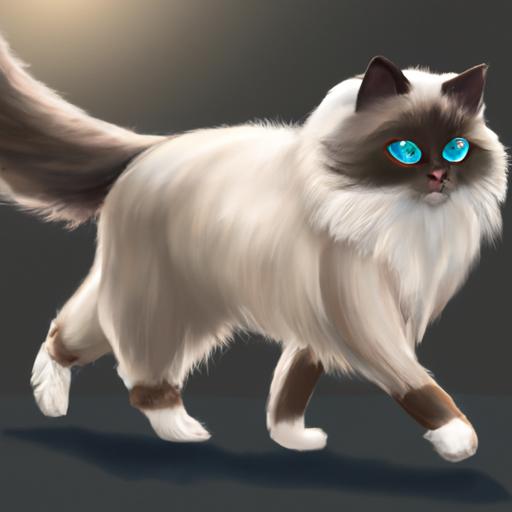Have you ever wondered what color your Ragdoll kitten will become once it’s fully grown? Or what the colorpoint pattern is and how it affects a Ragdoll’s color? You’re in luck! In this comprehensive guide, we’ll explore the ragdoll cat coloration process, when it begins, the possible coat colors, the colorpoint pattern, and the factors that affect coloration.
Whether you’re a curious cat parent or just enjoy learning about felines, this guide will answer all of your questions about Ragdoll coloration.
Let’s get started!.
Table of Contents
When Do Ragdolls Get Their Color?
Ragdolls typically get their color at around 8 to 10 weeks old, although it can take up to a year for the full color to be visible.
Some colors may take even longer to fully develop.
The Ragdoll Cat Coloration Process
The Ragdoll cat is a unique breed, with a stunning colorpoint pattern that sets them apart from other cats.
Born with all-white coats, the colors and patterns of the Ragdoll develop over time.
It typically takes 4-6 months for their coloration to fully develop, and by the time they reach one year of age, their colors and patterns are usually complete.
Ragdoll cats come in a variety of colors, including white, seal, blue, chocolate, lilac, red, and cream.
This colorpoint pattern is a recessive gene, meaning that both parents must have the gene in order to produce a kitten with this feature.
This colorpoint pattern is also unique to the Ragdoll breed, and can be used to distinguish it from other breeds.
In addition to the darker points, Ragdoll cats may also have shaded points, which are lighter than the dark points.
The color and pattern of a Ragdoll cats coat can change over time, becoming lighter or darker depending on the environment and the cats age.
This beautiful colorpoint pattern, combined with the Ragdoll’s friendly and laid-back personality, make them a popular choice among cat lovers.
If you’re looking for a beautiful and unique cat, look no further than the Ragdoll.
When Does Coloration Begin?

Ragdoll cats are one of the most unique and beautiful breeds of cats.
With their stunning coats and colorpoint patterns, they are sure to make an impression.
But what makes the Ragdoll cat so special? Ragdoll cats are born white, and their color and pattern develop over time.
The color of Ragdoll cats can vary from white, seal, blue, chocolate, lilac, red, or cream.
At around 8-10 weeks of age, the colorpoint pattern starts to become more distinct, with darker points on the face, ears, legs, and tail.
This colorpoint pattern will become more intense as the cat matures, reaching full color by the time they are a year old.
In addition to the colorpoint pattern, the body color of the Ragdoll cat starts to appear at around 4 months of age, becoming more intense as the kitten matures.
By the time the cat is a year old, it will have reached its full coloration.
The unique colorpoint pattern and color of the Ragdoll cat make it one of the most beautiful and captivating breeds.
They are sure to be a delight to any family or individual.
Possible Ragdoll Coat Colors
Ragdolls are a beautiful and unique breed of cats, known for their gorgeous coats.
Their coats come in a variety of colors and patterns, making them a popular choice for those looking for a cat with a distinct look.
Ragdolls can have several different coat colors, including white, seal, blue, chocolate, lilac, red, and cream.
The combination of genes inherited from both parents will determine the color of the coat.
The coat of a Ragdoll can also change over time, with maturity and the environment playing a role in the color and pattern of the coat.
Ragdolls are also known for their unique colorpoint pattern, which is darker points on the face, ears, legs, and tail.
The points are darker in color than the rest of the coat, ranging from a rich brown to a deep black.
Ragdolls can also have a marble pattern, which is a combination of lighter and darker colors, often with swirls or patches.
Additionally, Ragdolls can have a tabby pattern, which is a combination of stripes, swirls, and spots.
No matter what the combination of colors and patterns, Ragdolls are sure to be a beautiful addition to any home.
If youre looking for a unique and beautiful breed of cat, then a Ragdoll is the perfect choice.
The Colorpoint Pattern

The Ragdoll cat is known for its distinctive colorpoint pattern.
This pattern is characterized by darker points on the face, ears, legs, and tail, usually in shades of seal, blue, chocolate, lilac, red, or cream.
The colorpoint pattern is a result of the Ragdoll’s unique genetic makeup and is not found in other breeds of cats.
The colorpoint pattern can vary from cat to cat, but is usually consistent within the same breed.
This pattern is usually more apparent in adults as the cat matures, and the points may also have a gradient, blending into lighter shades.
The points are formed due to the gene that controls the temperature of the cat’s fur, so the points may vary in shades depending on the cat’s environment.
The colorpoint pattern is a unique feature of Ragdoll cats, and when combined with their beautiful blue eyes, large size and placid temperament, makes them one of the most sought after breeds of cats.
Their colorful and unique appearance makes them a delight to look at and a joy to own.
Factors That Affect Coloration
Ragdoll cats are known for their beautiful coats and patterns, but how do they get their colors? The answer lies in genetics, temperature, nutrition, light, and environment.
Genetics play a major role in determining a Ragdoll’s coat color and pattern.
These cats inherit their colors from their parents, with specific genes determining the type, shade, and pattern of the coat.
This means that two cats from the same parents can have different coat colors.
Temperature is also a significant factor in a Ragdoll’s coat color.
It is believed that if the temperature is lower during their development, their colors will be darker.
On the other hand, if the temperature is higher, their colors will be lighter.
Nutrition is another important factor affecting a Ragdoll’s coat color.
Certain nutrients in their diet can enhance or lighten the colors of their fur, while a lack of nutrients can make the colors appear duller or lighter.
Light exposure is also known to influence the colors in a Ragdoll’s coat.
Too much light can make their colors appear lighter, while too little light can make their colors appear darker.
Finally, the environment in which a Ragdoll is raised can also have an effect on their coat color.
If they are raised in a loud and chaotic environment, their coat may appear darker than one raised in a calmer and quieter environment.
In conclusion, Ragdolls get their beautiful coat colors and patterns from a combination of genetics, temperature, nutrition, light, and environment.
Understanding the influence of each of these factors can help owners better care for their furry friends and ensure they have a healthy and vibrant coat.
Final Thoughts
From the moment they are born to the time they reach full maturity, Ragdoll cats go through an interesting transformation of color and pattern.
By the time they reach 4 to 6 months, their color is already beginning to develop.
Ragdolls can come in a variety of colors and patterns, from white and seal to chocolate and lilac.
Each of these cats also have a unique colorpoint pattern that sets them apart from other cats.
With all this in mind, it’s clear that Ragdolls are truly one of a kind! Now that you know more about when and why Ragdolls get their color, you can love and appreciate your own Ragdoll all the more.

